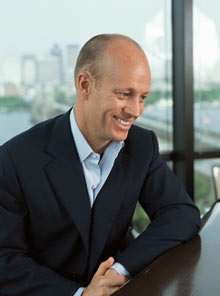In “A Zero-Emissions City in the Desert”, Kevin Bullis, Technology Review’s energy editor, writes of a nearly empty, dusty building site in the Persian Gulf: “[It] is the start of a vast experiment, an attempt to create the world’s first car-free, zero-carbon-dioxide-emissions, zero-waste city. Due to be completed in 2016, the city is the centerpiece of the Masdar Initiative, a $15 billion investment by the government of Abu Dhabi … . The new development, being built on the outskirts of Abu Dhabi city, will run almost entirely on energy from the sun and will use just 20 percent as much power as a conventional city of similar size.”

Nothing like Masdar City has ever been attempted. Although zero-emissions residences and commercial buildings already exist, larger clean buildings have never worked very well. Oberlin College’s Lewis Center already has some of the features that Masdar City’s designers wish to deploy on a grander scale; but the center consumed far more energy than its architects had anticipated, and only the addition of a solar array in a nearby parking lot allowed the college to claim, dubiously, that the building itself produced as much power as it used. Certainly, no one has ever raised a small city to these standards.
Insofar as many environmental engineers doubt that something as complex as a city could ever be entirely green, Masdar City is a triumph of optimism. But if the optimists are right, such a massive demonstration may be necessary. As the chief executive of a sustainable-design company puts it, “People say, ‘Gee, that would be great … but obviously it’s not possible.’ Once you can point at something, it takes away a lot of those arguments.”
Elsewhere in this issue of Technology Review, we unveil the 10 emerging technologies that we think have greatest potential to change our world. Among them is a nanofluidic chip that could lower the cost of sequencing DNA so that the entire human genome could be read in eight hours for less than $100. Lauren Gravitz explains, “Despite many experts’ doubt that whole-genome sequencing could be done for $1,000, let alone a 10th that much, BioNanomatrix [the startup that invented the chip] believes it can reach the $100 target in five years” (see “$100 Genome”). That would be a tremendous thing. A cheap, rapid sequencing tool could make personalized medicine a practical reality: a doctor could biopsy a malignant tumor in a patient’s lung, sequence its DNA, and then use the genetic information to design the treatment best suited for that particular variant of the cancer–“all for less than the cost of a chest x-ray.”
In another story (“But Who’s Counting?”), I describe how the absence of common tools for measuring the size of online audiences is threatening the future health of media, as print and broadcast television and radio shrink in importance: “No one really knows how many people visit websites. No established third-party supplier of audience measurement data is trusted. Internal Web logs exaggerate audiences.” This matters. Because the content on most websites is free, the only thing that will pay for anything like good journalism is the “display” or banner ads that publishers sell; but the inability to agree on audience numbers is stunting the growth of display advertising. As Roger McNamee, an investor in Forbes, puts it: “Getting this right is absolutely necessary for publishers to be able to continue to do interesting things.” No less an expert than McNamee himself confesses that “the remedy is not yet obvious.” Yet the story provides a reason for cautious optimism: an innovative San Francisco startup named Quantcast is working on new ways to more accurately measure online audiences.
All three stories point to a similar moral. Faced with large, pressing, global problems–how does one build a green city? Can medicine really be personalized? How can one save publishing?–conservative worthies fret that there may be no immediate solution. But the most innovative technologists are blithely optimistic about their inventions. They are sure that some application of existing or emerging technologies will force a breakthrough on big problems. They are not wholly irrational; they are not like those magical thinkers who proclaim that nothing is impossible if one only wants it sufficiently. But technologists do think they understand the difficulties that interest them, and they are happily confident that their particular combinations of technologies will be equal to the challenge.
Of course, their confidence may be misplaced. The great anxiety of editing Technology Review–and also its great fun–is that while we also understand the day’s big problems, we are never entirely certain at the time of publication, even with the best analysis and all our sources, that we have in fact chosen the solutions that will later make the conservative fretters sit up, eyebrows flying, and say, “Well, I’ll be damned.” But we’re optimistic that the technologies in this issue will be the ones that matter.
Write to me and tell me what you think at jason.pontin@technologyreview.com.
Keep Reading
Most Popular
Large language models can do jaw-dropping things. But nobody knows exactly why.
And that's a problem. Figuring it out is one of the biggest scientific puzzles of our time and a crucial step towards controlling more powerful future models.
The problem with plug-in hybrids? Their drivers.
Plug-in hybrids are often sold as a transition to EVs, but new data from Europe shows we’re still underestimating the emissions they produce.
How scientists traced a mysterious covid case back to six toilets
When wastewater surveillance turns into a hunt for a single infected individual, the ethics get tricky.
Google DeepMind’s new generative model makes Super Mario–like games from scratch
Genie learns how to control games by watching hours and hours of video. It could help train next-gen robots too.
Stay connected
Get the latest updates from
MIT Technology Review
Discover special offers, top stories, upcoming events, and more.